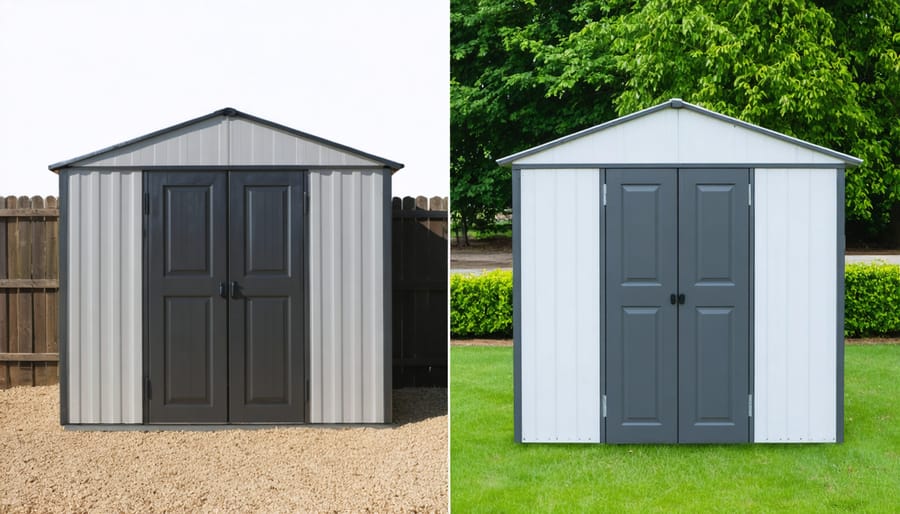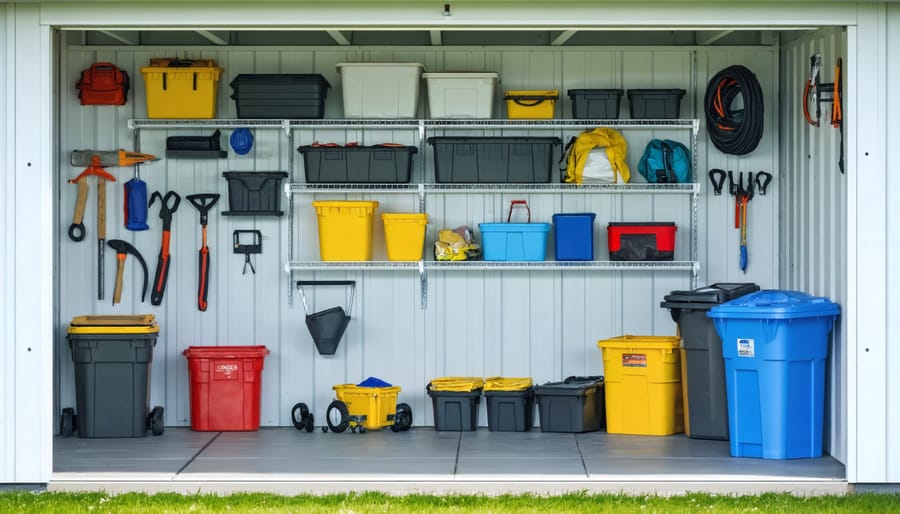Plastic Storage Sheds: The Real Truth About Durability and Value

Plastic storage sheds have revolutionized backyard storage solutions, offering homeowners a perfect blend of durability and convenience without the maintenance headaches of traditional wooden structures. Modern resin sheds withstand decades of harsh weather, resist rust and rot, and maintain their appearance far longer than their wooden counterparts. While initially met with skepticism, today’s high-quality plastic sheds feature reinforced panels, UV protection, and innovative ventilation systems that make them increasingly popular among practical homeowners. They’re not just functional—they’re smart investments that solve real storage challenges without breaking the bank or demanding weekend maintenance sessions. Whether you’re protecting garden equipment, storing seasonal decorations, or creating a workshop space, understanding the true capabilities and limitations of plastic sheds can help you make an informed decision that serves your needs for years to come.

The Surprising Benefits of Modern Plastic Sheds
Weather-Resistant Performance
One of the biggest advantages of plastic storage sheds is their exceptional weather resistance. Unlike metal sheds that can rust or wooden sheds that may rot, plastic sheds are specifically engineered to withstand various weather conditions. They’re built with UV-resistant materials that prevent fading and deterioration from sun exposure, ensuring your shed maintains its appearance year after year.
These sheds excel in wet conditions too. The synthetic materials won’t absorb moisture, preventing issues like mold, mildew, and water damage. Most quality plastic sheds feature built-in water management systems, including overlapping panels and sloped roofs that efficiently channel rainwater away from your stored items.
Temperature fluctuations pose little threat to plastic sheds. The materials are designed to handle both freezing winters and hot summers without warping or becoming brittle. Many modern plastic sheds incorporate double-wall construction, which provides additional stability and helps maintain a more consistent interior temperature.
While no outdoor structure is completely immune to extreme weather, plastic sheds require minimal maintenance to keep performing well. A simple occasional cleaning with soap and water is usually all that’s needed to keep them looking and functioning their best.
Maintenance-Free Living
One of the biggest advantages of plastic storage sheds is their virtually maintenance-free nature. Unlike wooden sheds that require regular painting, staining, and sealing, or metal sheds that can rust and need periodic touch-ups, plastic sheds stay looking fresh with minimal effort. A simple wash with soap and water once or twice a year is typically all that’s needed to keep them clean and presentable.
You won’t need to worry about rot, rust, or termites with a plastic shed, which eliminates many of the traditional maintenance tasks associated with outdoor storage structures. The color is integrated throughout the material, so there’s no paint to chip or peel. Even in harsh weather conditions, plastic sheds maintain their appearance without requiring protective treatments.
Should your plastic shed get dirty, a garden hose and mild detergent will do the trick. For tougher stains, a soft brush can be used without risking damage to the surface. The material naturally resists mold and mildew, making it ideal for humid climates. This low-maintenance aspect not only saves time but also reduces the long-term cost of ownership.
Common Concerns About Plastic Sheds (And the Reality)
Stability and Security
When it comes to stability and security, modern plastic storage sheds offer surprisingly robust features that make them a reliable choice for protecting your belongings. Most quality plastic sheds are engineered with reinforced panels and double-wall construction, providing excellent structural integrity even in challenging weather conditions.
The stability of plastic sheds largely depends on proper installation. A level foundation is crucial, and most models come with floor frames that can be anchored to a concrete pad or solid base. Many manufacturers include built-in metal support beams within the plastic components, adding extra rigidity to the structure without compromising the lightweight design.
For security, plastic sheds typically feature integrated locking systems and metal-reinforced door frames. While they may not be as naturally secure as metal alternatives, they can be easily upgraded with additional padlocks or security hardware. The door hinges are usually metal-reinforced to prevent easy removal, and many models include hasps for extra padlocks.
Wind resistance is another strong point, as quality plastic sheds are designed with interlocking panels that create a unified structure. Most can withstand significant wind speeds when properly anchored, though it’s important to follow the manufacturer’s guidelines for installation and maintenance to ensure optimal performance.
One notable advantage is that plastic sheds don’t rust or rot, maintaining their structural integrity over time without the need for frequent maintenance or repairs.

Longevity and Value
Modern plastic storage sheds offer impressive longevity when properly maintained, often lasting 15-20 years or more. While the initial cost might be higher than some basic metal alternatives, the durability of plastic sheds makes them a smart long-term investment. These structures don’t rust, never need painting, and resist weather damage remarkably well.
When considering value, factor in the minimal maintenance requirements. Unlike wooden sheds that need regular sealing, painting, and protection against rot, plastic sheds typically only require occasional cleaning with soap and water. This saves both time and money over the years. Many homeowners report spending less than $50 annually on maintenance, compared to several hundred dollars for wooden alternatives.
The cost-effectiveness becomes even more apparent when you consider the shed’s resistance to pests. While wooden structures might require periodic treatment for termites and other insects, plastic sheds naturally deter these unwanted visitors. Additionally, most quality plastic sheds come with extended warranties, often 10 years or more, providing peace of mind and protecting your investment.
For maximum value, choose a reputable brand and ensure proper installation on a level surface. This initial attention to detail can significantly extend your shed’s useful life and maintain its appearance for years to come.
Making the Most of Your Plastic Shed
Foundation and Installation Tips
A solid foundation is crucial for ensuring your plastic storage shed stands the test of time. Before installation, take time to determine the best foundation for your shed. While plastic sheds are lighter than their wooden counterparts, they still require a level, stable base to prevent warping and structural issues.
For optimal results, consider using a concrete pad, crushed stone, or paver base. These options provide excellent drainage and stability. If you choose crushed stone, aim for a depth of at least 4 inches, compacted well and perfectly level. For concrete, ensure it’s at least 4 inches thick and extends slightly beyond your shed’s footprint.
Before assembly, check your local building codes and obtain necessary permits. Choose a location that’s easily accessible and away from areas prone to water pooling. Most plastic sheds come with pre-drilled holes for anchoring – don’t skip this crucial step! Use appropriate anchors to secure your shed to the foundation, preventing lift during strong winds.
Installation tip: Choose a calm, mild day for assembly, as extreme temperatures can affect plastic’s flexibility. Having an extra pair of hands during installation makes the process smoother and ensures panels align correctly. Remember to install proper drainage around your foundation to prevent water accumulation, which could compromise stability over time.

Organization and Storage Solutions
Making the most of your plastic storage shed starts with smart organization. To maximize your storage space, consider installing adjustable shelving units along the walls. These shelves can be easily modified as your storage needs change and won’t damage the shed’s structure.
Vertical storage is key in plastic sheds. Use wall-mounted pegboards or track systems to hang garden tools, keeping them off the floor and easily accessible. Install hooks on support beams for lighter items like hoses and extension cords. Many plastic sheds come with built-in shelf supports or mounting points, making organization even simpler.
Plastic storage bins work particularly well in these sheds, as they protect items from moisture and stack efficiently. Consider clear containers to easily identify contents, and label everything for quick access. Use corner spaces effectively by installing corner shelves or placing triangular storage units.
For frequently used items, consider adding a small workbench or portable storage cabinet near the entrance. This creates a functional workspace while maintaining easy access to everyday tools. Remember to leave clear pathways and ensure heavier items are stored at ground level for safety and stability.
Don’t forget the ceiling space – many plastic sheds can accommodate overhead storage racks for seasonal items, providing additional storage without compromising floor space.
Plastic storage sheds have proven themselves to be a worthwhile investment for many homeowners, offering a practical balance of durability, convenience, and value. Throughout our exploration, we’ve seen that these structures excel in several key areas: they’re weather-resistant, require minimal maintenance, and provide reliable protection for your belongings without the constant upkeep traditional wooden sheds demand.
While they may not match the classic aesthetic of wooden sheds, modern plastic sheds come in attractive designs that can complement various home styles. Their lightweight nature makes installation straightforward, and their resistance to rot, rust, and pests provides peace of mind for long-term storage solutions.
For best results, we recommend choosing a high-quality plastic shed from a reputable manufacturer, ensuring proper foundation preparation, and following installation instructions carefully. Regular cleaning and seasonal checks will help maintain your shed’s appearance and functionality for years to come.
That said, plastic sheds aren’t perfect for every situation. If you live in an area with extreme temperature fluctuations or need to store heavy power equipment, you might want to consider alternative options. However, for most homeowners looking to store garden tools, outdoor furniture, or general household items, a plastic shed represents an excellent choice.
The verdict? Plastic storage sheds are indeed a good investment when matched with appropriate use cases and proper installation. Their combination of durability, low maintenance requirements, and practical features makes them an smart choice for modern homeowners seeking reliable outdoor storage solutions.

